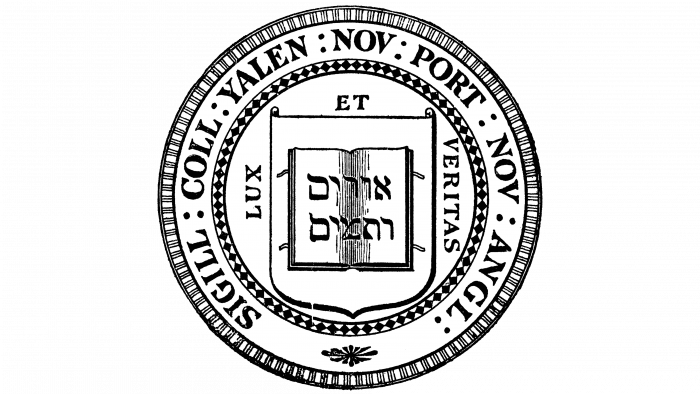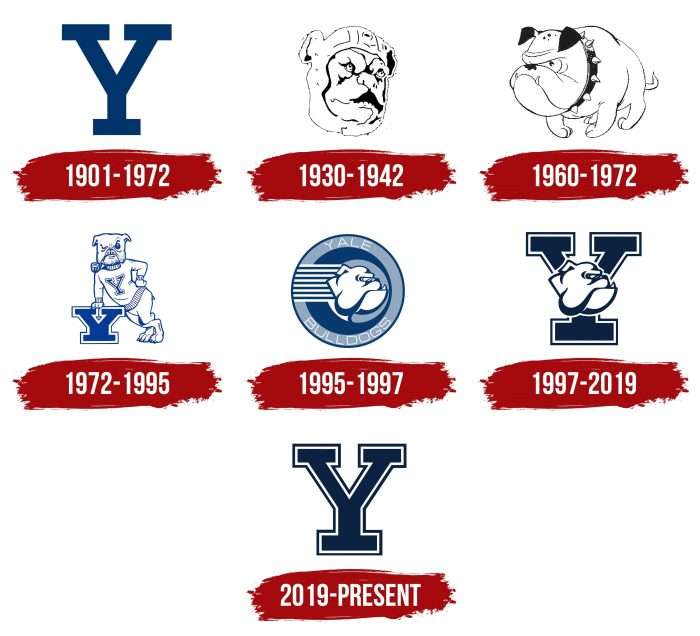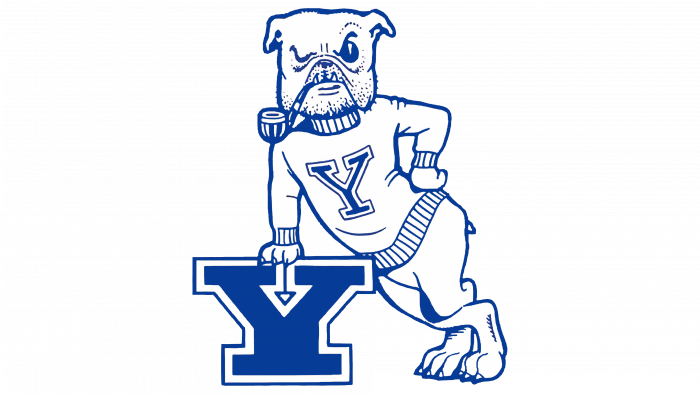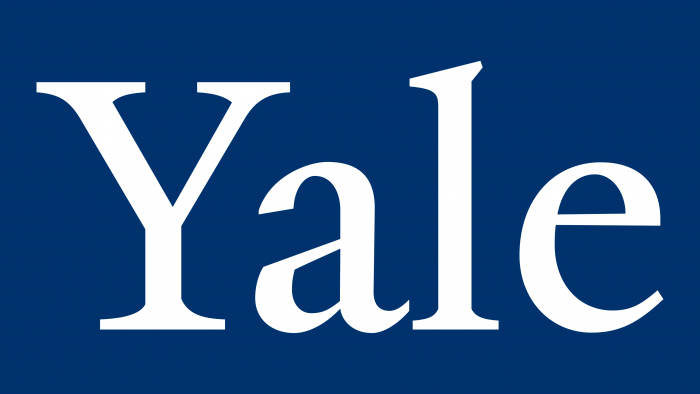The Yale logo, like the ivy league university badge, is very simple. However, small details demonstrate style, while simplicity and conciseness symbolize rigor and a businesslike approach. When looking at the emblem, it becomes clear that training is given a paramount role here.
Yale: Brand overview
| Founded: | October 9, 1701 |
| Headquarters: | New Haven, Connecticut, United States |
| Website: | yale.edu |
Meaning and History
This institution of higher education originated from the An Act for Liberty to Erect a Collegiate School, approved by the General Court Colony of Connecticut. This happened in October 1701, intending to train the clergy and secular leadership of the state. The founders included many people, including Samuel Andrew, Samuel Mather, Israel Chauncy, Thomas Buckingham, and many others. James Pierpont headed the group.
The institute was initially based in the home of the first president of Yale University, Abraham Pierson. He lived in the city of Killingworth (now – Clinton). Then the educational institution was moved to Saybrook and later to Wethersfield. In New Haven, Connecticut State, this educational institution appeared in 1716.
To adequately settle in a new place, the priest Cotton Mather, at the insistence of the leadership (the rector of the university Samuel Andrew or the governor of the colony Gurdon Saltonstall), turned to the successful Boston businessman Elihu Yale with a request to help in the construction of the new building. He, in turn, provided them with nine bales of goods, which were subsequently sold for 560 pounds sterling, which made it possible to build the main building. At the same time, Cotton Mather proposed to name the university in honor of the sponsor – Yale College.
The Yale University crest comprises three key components that are of immense importance to the institution. The open book is not only a symbol of enlightenment. Some researchers see in her an image associated with theology and church clergy who founded the university. They assume it is a Bible open to a page with an important message to posterity. The inscription is in Hebrew.
The background of the white and yellow book is a dark blue shield of the correct shape: an even top, a narrowed bottom. Along the edge, it is outlined with a black stripe that runs along the entire contour. Below is a tape with bifurcated ends and a dictum in Latin “Lux et Veritas.” This is the motto of the university. On both sides of the book, there are strings that were used to seal paper editions.
The modern emblem of Yale University contains part of its name – the first word. It is made with classic printed characters – straight lines, with miniature serifs. But “A” is different from the usual version. Its central part is not completely round but slightly cut diagonally. “E” has an overly large bottom and a disproportionately small top. The inscription is made in the form of a combination of one uppercase and three lowercase letters.
Yale Bulldogs Logo
The university has its own sports club, whose representatives compete in several interuniversity programs. They are part of NCAA Division I, Ivy League, ECAC Hockey, NEISA. The most famous are the football and ice hockey teams, which are considered among the oldest in the college system. The club plays at the Yale Bowl Arena and has an interesting history of logos.
1901 – 1972
The history of the logos of the sports department, owned by Yale University, began with the “Y” sign. It is very symbolic for the university since it denotes several concepts at once: the location of the higher educational institution, as well as its name, which has been transferred to university teams. It was decided to make the initial letter an independent emblem to show their unity. It is large, blue, complemented by rectangular serifs.
1930 – 1942
Sports emblems have nothing to do with university symbols. They contain completely different images. The debut version features the head of a bulldog wearing a football player’s leather helmet. The drawing is executed in sinuous blue lines and is set against a white background. The dog’s gaze seems to be riveted to some object, which it closely follows, slightly tilting its head. The design is line-like, so the bulldog appears to emerge from negative space.
1960 – 1972
The club chose a realistic drawing of a dog as its logo. The bulldog is depicted standing on four legs and with an arrogantly raised muzzle. His gaze is formidable, fangs eerily protrude from his lower lip, his forehead is wrinkled, and his ears are thrust forward. The animal is wearing a black collar with large spikes.
1972 – 1995
During this period, the anthropomorphic dog logo was used. She stands tall, crossing her legs and leaning her elbows on a large “Y.” The eyes of the bulldog are large and black, and the gaze is intent. The animal is wearing a sweater with the name of the university. The big letter on which the dog is leaning has two edging stripes – black and white.
1995 – 1997
As a result of the redesign, the logo received a completely different interpretation – a serious, stylish, aggressive one. The developers turned the dog’s head in profile and placed it in the center of the circle on a light blue spot. It is followed by a larger circle – a dark shade. Next comes a wide strip with the name of the sports department: at the top is the word “Yale,” and at the bottom – “Bulldogs.” Both inscriptions are typed in a thin grotesque. The letters are white, with minimal intercharacter space. Along the edge of the emblem is a dark blue ring that replaces the frame. But the most interesting element of the visual identity is the 15 stripes. They overlap all layers and add dynamics to the logo.
1997 – 2019
The current version is abstract: it contains only the capital “Y” and the bulldog’s head, located sideways. He looks to the right and looks very menacing. Moreover, the designers returned to the stroke-like style of drawing, so the dog again seems to emerge from the negative space. Its background is the first letter of the name Yale University. The author of this version is graphic artist Jeffrey Russo.
2019 – today
The current version of the logo is a reincarnation of the debut emblem. This is its improved version since a double border has been added to the existing letter: white (inner line) and dark blue (outer frame).
Yale: Interesting Facts
Yale University, founded in 1701, is one of the oldest and most respected universities in the U.S., known for its deep history, academic excellence, and societal contributions.
- Beginnings: It started as the Collegiate School in Saybrook, Connecticut, and Yale moved to New Haven in 1716 to train clergy and leaders. It was renamed Yale College in 1718 after Elihu Yale, a major benefactor.
- Famous Alumni: Yale’s graduates include U.S. Presidents like George H.W. Bush and Bill Clinton, Supreme Court Justices like Clarence Thomas and Sonia Sotomayor, and leaders in every field, from literature to science.
- Secret Societies: Known for its secret societies like Skull and Bones, Yale has a long tradition of exclusive clubs that include some of the country’s most influential people.
- Research and Academics: Yale is a leader in research, and it boasts the first university art gallery in the Western hemisphere and has made significant contributions to medicine, law, and environmental science.
- Residential Colleges: Adopting a system similar to Oxford and Cambridge, Yale’s residential colleges offer a close-knit community within the larger university, enhancing the student experience.
- D. Milestone: Yale awarded the first Ph.D. in the U.S. in 1861, setting a precedent in graduate education.
- Arts Contribution: Yale is also celebrated for its arts programs, including globally recognized Schools of Drama, Music, and Art. It houses major art collections and actively supports cultural endeavors.
- Sustainability Efforts: Yale is committed to environmental stewardship. It works to reduce emissions, conserve resources, and support sustainable food practices.
- Global Influence: Yale impacts the world through its Yale World Fellows program, international research partnerships, and global centers, preparing students for worldwide leadership.
Yale stands out for its blend of tradition, academic rigor, and dedication to making a difference and shaping leaders and innovators worldwide.
Font and Colors
The identity of the oldest university in the United States contains iconic elements that reflect the history of its origin. But sports symbols are more modern and have nothing to do with legendary images. It is dominated by the bulldog, which appeared thanks to the sports department Yale Bulldogs. The last logo was nicknamed Y-Dog.
The original typeface is called Yale. It was designed by Matthew Carter, an art professor, using the oldest typeface, De Aetna. Its author is Francesco Griffo, who created the typeface back in 1495. In 2014, the university completely overhauled its typography when Carter & Cone introduced an updated set of Yale fonts in the OpenType standard. This format has replaced the outdated PostScript Type 1. Now the family of university typefaces consists of almost 30 variants.
In addition, the school has its color – Yale Blue. It is available in two shades: spot and triad. Introduced in the late 1800s, it is now found in all identity signs. Typically, a logo combines blue with white. Some emblems and coats of arms also use black and yellow.
Yale color codes
| Dark Midnight Blue | Hex color: | #00356b |
|---|---|---|
| RGB: | 0 53 107 | |
| CMYK: | 100 50 0 58 | |
| Pantone: | PMS 294 C |















